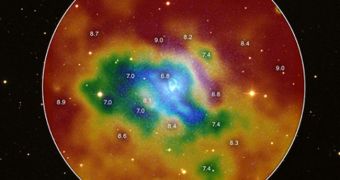For many years, astrophysicists have been debating the role that supermassive black holes play in the galactic development process. Galactic temperatures are among the main factors dictating the evolution of this type of structures, and experts have recently found the perfect place to investigate the relation.
The galaxy, called NGC 5813, is located in the Virgo III Group, a component of the massive Virgo Supercluster of galaxies. The cluster has a diameter of 110 million light-years.
The Virgo SC also contains the Local Group, which is the home of the Milky Way and its closest neighbor, the Andromeda galaxy.
An international team of astronomers used the NASA Chandra X-Ray Observatory to look at the galaxy, and investigate its central region, which is classified as an Active Galactic Nucleus (AGN).
An AGN is a galactic core that features much-higher-than-normal luminosity in at least one portion of the electromagnetic spectrum, if not a majority of them, Universe Today reports.
In most cases, such a structure is powered up by a supermassive black hole at its center, which is why the researchers selected this object for the X-ray investigation.
One of the main conclusions of the new study was that the AGN produces regular outburst shock waves, which travel through the surrounding gas, preventing it from cooling down.
“Although there are other systems that show AGN outburst shocks, this is still the only system where unambiguous shocks from multiple outbursts are seen,” explains Harvard-Smithsonian Center for Astrophysics (CfA) expert Dr. Scott Randall.
The scientist, who is a member of the CfA Chandra Mission Planning Team, is also the coauthor of a new paper detailing the findings, which will appear in an upcoming issue of the Astrophysical Journal.
“This allows us to directly measure the heating from shocks, and directly observe how often these shocks take place. Thus, at present NGC 5813 is 'uniquely' well suited to the study of AGN heating,” the astronomer goes on to say.
Chandra readings were combined with datasets collected by the Giant Metrewave Radio Telescope (GMRT) and the Southern Astrophysical Research Telescope (SOAR) observatories, so that researchers could get the full picture of what is going on at the core of NGC 5813.
Investigators say that AGN outbursts may have occurred 3 million, 20 million and 90 million years ago, respectively, as demonstrated by large cavities in the galaxy's central region.
“This is an important result for stellar formation and galaxy evolution. The AGN heats the gas, preventing it from cooling and forming large amounts of stars,” Randall explains.
“There have been several galaxy evolution models proposed that require this kind of 'AGN feedback' near the centers of galaxies to explain the observed differences in galaxies,” he adds.
“Here we show explicitly that this kind of feedback can and does take place, at least in this system,” the expert concludes.

 14 DAY TRIAL //
14 DAY TRIAL //